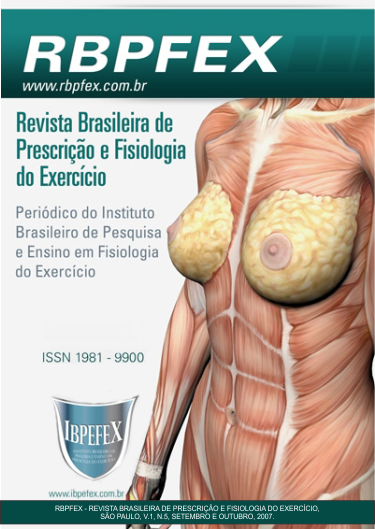Consumo máximo de oxigênio de jogadores de futebol profissional de uma equipe potiguar: comparação entre diferentes posições
Resumo
Cada vez mais no futebol utiliza-se o auxílio da tecnologia para se melhorar o desempenho dos atletas. Entre as variáveis físicas envolvidas nesse esporte destaca-se o consumo máximo de oxigênio (VO2máx), por ser um índice relevante na predição de condição aeróbica, além de servir como parâmetro para prescrição de treinamento. O objetivo desse estudo foi comparar os valores de VO2máx entre jogadores profissionais de diferentes posições de uma equipe Potiguar. Foram revisados 36 exames ergoespirométricos de atletas do ABC futebol clube, com idade de 26,54 ± 4,51 anos, massa corporal 75,95 ± 7,15kg, estatura 1,79 ± 0,06m e IMC de 23,67 ± 1,48kg/m2 entre os anos de 2005 e 2007. Os atletas foram divididos em cinco grupos: goleiros (GO); zagueiros (ZG); laterais (LT); meio-campistas (MC) e atacantes (AT). Como resultado de VO2máx entre os grupos verificou-se os seguintes valores: GO = 50,1 ± 3,04* ml/(kg.min); ZG = 56,85 ± 4,29 ml/(kg.min); LT = 59,21± 2,3* ml/(kg.min); MC = 57,18 ± 4,68* ml/(kg.min) e; AT = 55,7 ± 5,29 ml/(kg.min). De acordo com os resultados obtidos é possível concluir que houve diferença significante apenas entre o grupo GO com relação aos grupos LA e MC. Portanto, na população estudada, os goleiros apresentaram menor média de VO2máx, e os laterais e meio-campistas as melhores aptidões cardiorrespiratórias.
Referências
-Aoki, M.S. Fisiologia, Treinamento e Nutrição aplicados ao Futebol. São Paulo: Fontoura, 2002.
- Balikian, P; Lourenção, A; Ribeiro, L.F.P; Festuccia, W.T.L; Neiva, C.M. Consumo máximo de oxigênio e limiar anaeróbio de jogadores de futebol: comparação entre as diferentes posições. Rev Bras Med Esporte, v. 8, n. 2, 2002.
- Barros Neto, Tl; Tebexreni, A.S; Tambeiro, V.L. Aplicações práticas da ergoespirometria no atleta. Rev. Soc. Cardiol. Estado de São Paulo, v. 11, n. 3, 2001.
- Cohen, M; Abdalla, R.J; Ejnisman, B; Amaro, J.T Lesões Ortopédicas no Futebol. Rev Bras Ortop., v. 32, n. 12, 1997.
-Edwards, A.M; Clark, N; Macfadyen, A.M; Lactate and ventilatory thresholds reflect the training status of professional soccer players where maximum aerobic power is unchanged. Journal of Sports Science and Medicine v. 2, 2003.
-Fletcher, G.F; Balady, C.G; Froelicher, V.F. e colaboradores. Exercise standards for testing and training. A statement for healthcare professionals from the American Heart Association. Circulation v. 104, p. 1694-740, 2001.
-Helgerud, J; Engen, L.C; Wisloff, U; Hoff, J. Aerobic endurance training improves soccer Performance. Med. Sci. Sports Exerc., v. 33, n. 11, 2001.
- Hoff, J; Wisloff, U; Engen, L.C; Kemi, O.J; Helgerud, J. Soccer specific aerobic endurance training. Br. J. Sports Med. v. 36, 2002.
-Klissouras, V. Heritability of adaptive variation. J Appl Physiol., v. 31, n. 3, 1971.
- Metaxas, T.I; Koutlianos, N.A; Kouidi, E.J; Deligiannis, A.P. Comparative study of field and laboratory tests for the evaluation of aerobic capacity in soccer players. J. Strength Cond. Res., v. 19, n. 1, 2005.
- Myers, J.; Buchanan, N.; Walsh, D.; Kramer, M.; Mcauley, P.; Hamilton-Wessler, M.; e colaboradores. Comparison of the ramp versus standard exercise protocols. JACC v. 17, n. 3, 1991.
- Raymundo, J.L.P; Reckers, L.J; Locks, R; Silva, L; Hallal, P.C. Perfil das lesões e evolução da capacidade física em atletas profissionais de futebol durante uma temporada. Rev Bras Ortop., v. 40, n. 6, 2005.
- Rosch, D; Hodgson, R; Peterson, L; Graf-Baumann, Mdt; Junge, A; Chomiak, J; Dvorak, J. Assessment and Evaluation of Football Performance. American Journal of Sports Medicine, v. 28, n. 5, 2000.
- Santos, J.A.R. Estudo comparativo, fisiológico, antropométrico e motor entre futebolista de diferente nível competitivo. Rev. Paul. Educ. Fís. v. 13, n. 2, 1999.
- Serra, S. Considerações sobre ergoespirometria. Arq Bras Cardiol., v. 68, n. 4, 1997.
-Shepard, R.J. Biology and medicine of soccer: an update. J Sports Sci., v. 17, 1999.
-Stolen, T; Chamari, K; Castagna, C; Wisloff, U. Physiology of Soccer. Sports Med., v. 35, n. 6, 2005.
- Yazbek P, Carvalho Rt, Sabbag Lms, Battistella LR. Ergoespirometria. Teste de Esforço Cardiopulmonar, Metodologia e Interpretação. Arq Bras Cardiol., v. 71, n. 5, 1998.
Autores que publicam neste periódico concordam com os seguintes termos:
- Autores mantém os direitos autorais e concedem ao periódico o direito de primeira publicação, com o trabalho simultaneamente licenciado sob a Creative Commons Attribution License BY-NC que permitindo o compartilhamento do trabalho com reconhecimento da autoria do trabalho e publicação inicial neste periódico.
- Autores têm autorização para assumir contratos adicionais separadamente, para distribuição não-exclusiva da versão do trabalho publicada neste periódico (ex.: publicar em repositório institucional ou como capítulo de livro), com reconhecimento de autoria e publicação inicial neste periódico.
- Autores têm permissão e são estimulados a publicar e distribuir seu trabalho online (ex.: em repositórios institucionais ou na sua página pessoal) a qualquer ponto antes ou durante o processo editorial, já que isso pode gerar alterações produtivas, bem como aumentar o impacto e a citação do trabalho publicado (Veja O Efeito do Acesso Livre).






